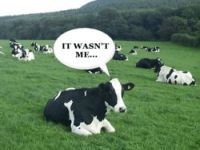Climate Change: The case of the cows' bowels and oregano
To the rescue, to save the planet. Not a sophisticated plan of action drawn up by the world's top scientists, no rocket science engineers, no United Nations brokered scheme to charge the ionosphere with particles to block out the Sun, no climate change summit. Just plain and simple oregano - not on your pizza but in the cow's bowel.
 The cow's bowel?
The cow's bowel?
Yes because a substantial quality of Greenhouse Effect Gas is produced by cows and other ruminating animals breaking wind. To be exact, 16 per cent of GEG is produced by cows, deer, goats and sheep as methane gas is produced by their digestive system. The way it works is like this: bacteria in the rumen, one of the stomachs operating the digestive process of these animals, ferment the vegetation they eat to free its nutrients. One of the sub-products is methane gas.
So where does oregano come into the equation?
It has two advantages. Not only does oregano added to the diet of these animals reduce the production of methane gas by 40 per cent but in the case of cows, also increases the production of milk. And this is important because methane is 23 times more harmful to the environment than carbon dioxide in terms of effects on global warming.
Rising up through the atmosphere, it forms a layer round the Earth which retains solar radiation.
And how does it work?
Well, scientists from the University of Pennsylvania, USA, discovered that by adding an oregano supplement to the food consumed by bovines, the methane-producing bacteria in the gut are suppressed. The author of the report, Dr. Alexander Hristov, declares that "The oregano apparently also inhibits other species of bacteria but without affecting the global fermentation process in the abdomen".
The eight cows taking part in the study produced on average one and a half liters more milk than those in the control group, possibly due to the fact that the cows do not lose energy through expelling methane gas (around 7 per cent of the energy stored in the food). This energy in turn is turned towards the production of milk.
Source: IG
Olga SELYANINA
Translated from the Portuguese version
Subscribe to Pravda.Ru Telegram channel, Facebook, RSS!





